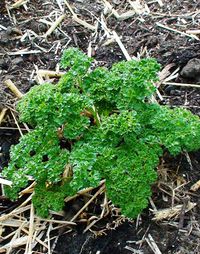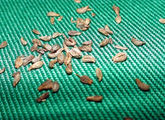Difference between revisions of "Parsley"
(Created page with "200px|thumb|right|Young parsley plant == Chunks of information == * == Gallery == <gallery caption="" widths="170px" heights="120px" perro...") |
|||
| (3 intermediate revisions by the same user not shown) | |||
| Line 1: | Line 1: | ||
[[File:Young parsley plant.jpg|200px|thumb|right|Young parsley plant]] | [[File:Young parsley plant.jpg|200px|thumb|right|Young parsley plant]] | ||
| + | In March you can sow in a cold frame or greenhouse, from April through August you can sow outside. Sow in a soil that is fertilized but don't add fresh compost. It grows best in moist, well drained soil, with full sun. Parsley is not hardy in the winter but you can commonly keep them under glass. | ||
| + | Germination is slow, taking four to six weeks. I usually sow them in pots and plant them out later. | ||
| − | + | Parsley is widely used as a companion plant in gardens. Like many other members of the carrot family, it attracts predatory insects, including wasps and predatory flies to gardens, which then tend to protect plants nearby. | |
| − | + | ||
| + | You can cut the leaves whenever the plant is big enough to do so. There also exists root parsley, a variety of which the roots are used. | ||
| + | |||
| + | Parsley is high in vitamins A, B, and C. Traditionally. parsley has been used for congestion and inflammation of the kidneys and bladder, gravel, stones, and urine retention. The root and leaves are excellent for the liver and spleen. Parsley is a very reliable diuretic remedy. Parsley root and seeds contain ingredients that help produce a pain relieving benefit to relax stiff joints.<ref>[http://www.greenmuze.com/blogs/natural-notes/1098-health-benefits-of-parsley.html Health benefits of parsley]</ref><br clear="all"/> | ||
== Gallery == | == Gallery == | ||
<gallery caption="" widths="170px" heights="120px" perrow="4"> | <gallery caption="" widths="170px" heights="120px" perrow="4"> | ||
| − | + | File:Parsley seeds.JPG|Parsley seeds | |
</gallery> | </gallery> | ||
| Line 13: | Line 18: | ||
* [[Gardening courses]] | * [[Gardening courses]] | ||
* [[Knowledge base:Gardening]] | * [[Knowledge base:Gardening]] | ||
| + | |||
| + | == References == | ||
| + | <references/> | ||
== External links == | == External links == | ||
* [http://en.wikipedia.org/wiki/Parsley Parsley] Wikipedia | * [http://en.wikipedia.org/wiki/Parsley Parsley] Wikipedia | ||
| + | |||
| + | ==Comments== | ||
| + | |||
| + | {{#widget:Improved Facebook Comments | ||
| + | |||
| + | |appID={322309441168104} | ||
| + | |||
| + | |url={{fullurl:{{PAGENAME}}}} | ||
| + | |||
| + | |num=5 | ||
| + | |||
| + | |width=650 | ||
| + | |||
| + | }} | ||
| + | |||
| + | [[Category:Gardening]] | ||
| + | [[Category:Medicinal plants & herbs]] | ||
| + | [[Category:Plants]] | ||
Latest revision as of 07:06, 28 June 2012
In March you can sow in a cold frame or greenhouse, from April through August you can sow outside. Sow in a soil that is fertilized but don't add fresh compost. It grows best in moist, well drained soil, with full sun. Parsley is not hardy in the winter but you can commonly keep them under glass.
Germination is slow, taking four to six weeks. I usually sow them in pots and plant them out later.
Parsley is widely used as a companion plant in gardens. Like many other members of the carrot family, it attracts predatory insects, including wasps and predatory flies to gardens, which then tend to protect plants nearby.
You can cut the leaves whenever the plant is big enough to do so. There also exists root parsley, a variety of which the roots are used.
Parsley is high in vitamins A, B, and C. Traditionally. parsley has been used for congestion and inflammation of the kidneys and bladder, gravel, stones, and urine retention. The root and leaves are excellent for the liver and spleen. Parsley is a very reliable diuretic remedy. Parsley root and seeds contain ingredients that help produce a pain relieving benefit to relax stiff joints.[1]
Gallery
See also
References
External links
- Parsley Wikipedia


